Consumer confidence in Central Asia in July 2024: Positive July for the entire region

For the thirteenth month, Freedom Finance Global has been researching consumer confidence, inflation and devaluation expectations of residents of four Central Asian countries: Kazakhstan, Uzbekistan, Kyrgyzstan and Tajikistan. In July 2024, two countries immediately experienced noticeable changes in the previously set trends, while the dynamics of inflationary and devaluation sentiment turned out to be mostly mixed and neutral.
In July, the Consumer Confidence Index (CCI) in Kazakhstan continued growing for the fourth month in a row, although this time the pace was small. Kyrgyzstan shows an increase in optimism for the fifth month in a row, reaching new records and confidently taking second place. In the other two countries, the previous trends have stopped. In Uzbekistan, the negative dynamics that lasted for three months in a row disappeared after a slight recovery in the CCI. Tajikistan, after a neutral trend for four months in a row, showed a sharp increase in the CCI consumer optimism updating the absolute records for the region for the entire research.
In Kazakhstan and Uzbekistan, analysts collect 3,600 questionnaires each month, 1,600 in Kyrgyzstan, 1,200 in Tajikistan, pro rata the size of the population in the countries under research. The research is based on the methodology used to obtain consumer confidence indexes in many countries around the world and adapted to local needs by the United Research Technologies Group research company. Data collection method: telephone survey. The survey questionnaire is localized: the research is conducted in the native language of the respondents.
Kazakhstan
In July, the Consumer Confidence Index (CCI) continued to improve in Kazakhstan for the fourth month in a row. However, this time the index growth was small: 0.4 points. The index itself reached 104.2 points, which is the third best result for the entire research. A moderate improvement in sentiment occurred in all sub-indexes, except the one-year economic outlook question. Nevertheless, the decline was also moderate and within the usual monthly fluctuations. In comparison with last year’s July, the CCI increased by 2.7 points, largely due to a significant improvement in the population’s assessments of the changing economic situation.
Continued growth of positive personal financial situation
The sub-index of past changes in personal financial status over the previous 12 months also rose for the fourth month in a row. This time, the increase was 1.1 points, and the sub-index reached 105.6 points. The share of those who believe that their personal financial situation has improved has changed slightly: 32.4% in July against 32.8% in June. However, over the past month, the share of those who gave an unambiguously positive answer has increased significantly: 13.1% against 11.7%.
Among the age groups, young people under the age of 29 showed a strong improvement in their results. Among them, the share of positive respondents increased from 42 to 48.6%, thereby strengthening their leadership among age groups. On the other hand, the situation is reversed among people over the age of 60. If in June 24.8% of this group gave a positive answer, then it was already 18% in July.
In the regional context, the greatest increase in positive responses to changes in personal financial situation is observed in Akmola and Aktobe regions, where the share of positive responses increased by 8.8 and 7.9 p.p., respectively. Nevertheless, the largest share of optimists is recorded in the West Kazakhstan region, where it reaches 37.8%. The worst response was given in Zhetysu region, where this share fell by 6.1 p.p. and amounted to only 23.2%.
Estimates of the economic situation have improved markedly over the past year
In comparison with July 2023, the largest increase is shown by the sub-index of estimates of changes in the economic situation, which increased by 5.6 points and reached 78.5 points in July 2024. This result was a repeat of the best indicator this year, which was recorded in January. At the same time, the share of Kazakhstanis who believe that the economic situation has improved over the previous 12 months has practically not changed (17.1% against 16.7%), but the share of negative responses has decreased: from 47.7 to 41.5%.
Among the age groups, the greatest decrease in the level of pessimism is observed in people aged 30-44 years. Among them, 42% gave a negative answer, while their share was almost 50% in last year. The same indicators also decreased significantly (6.2-6.4 p.p.) in the other two older age groups.
Nevertheless, people aged 45-59 with a share of 43.3% made the most negative assessment of economic changes. Young people under the age of 29 showed the best result, where the share of pessimists is only 33%, which is 3.6 p.p, less than last year.
In the regional context, Pavlodar region showed the best progress, where the share of negative responses fell from 55.2% to 41.8%. Nevertheless, residents of Atyrau region responded best this July, where the same share reaches only 22.7%, although it increased by 4.5 p.p. in comparison with last year. In Almaty, the share of pessimists was 52.3%, which is significantly higher than in the rating.
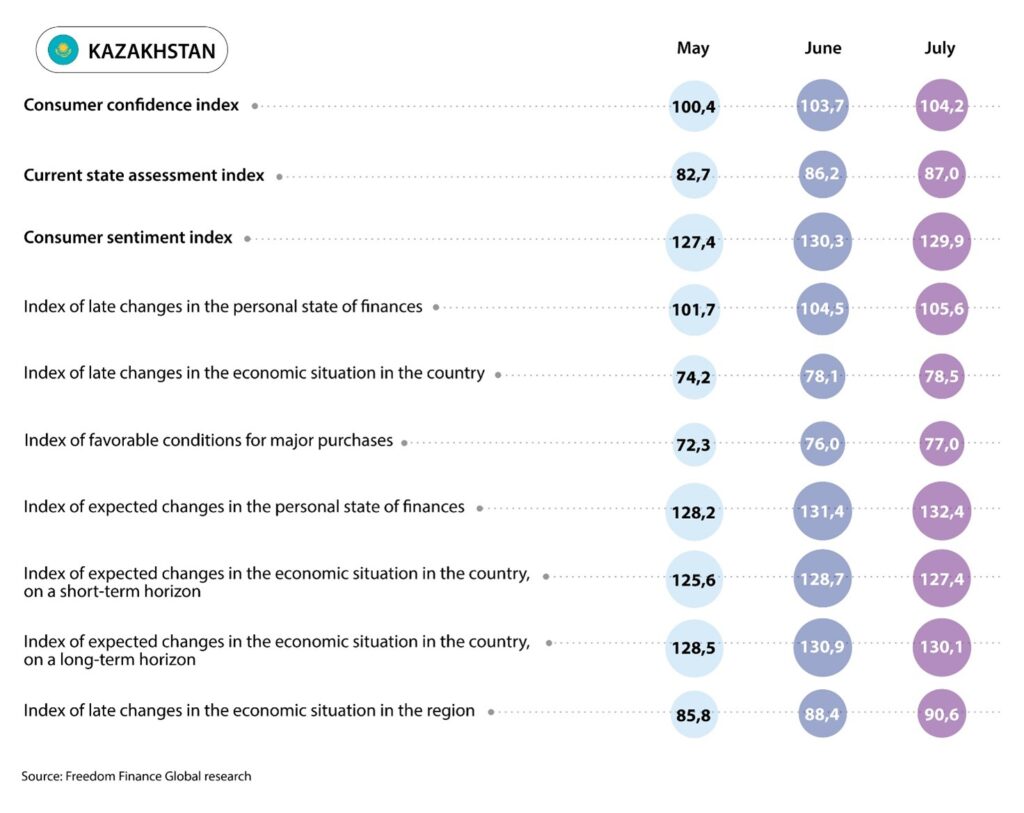
Inflation expectations of Kazakhstanis slightly increased
Inflation estimates of Kazakhstanis generally remained at the same levels after updating records for several months in a row. Over the past month, 39.1% of residents (39% in June) noticed a strong increase in prices. In the horizon of the past year, it turned out to be slightly more significant. The share of those who noticed a faster price increase has grown from 52 to 52.7%.
On average, the inflation expectations of Kazakhstanis have grown much more significantly. The share of people who expect strong price growth in the one-month horizon increased from 16% to 17.3%, and in the next 12 months, slightly more people expect an acceleration in price growth: from 20.9% to 22.2%.
A similar inflation estimates and expectations survey by the National Bank of Kazakhstan generally showed a downward trend. According to the survey, the share of people expecting strong price growth during the year fell from 26.4% to 24.4%. While in the one-month horizon, the same indicator increased from 18.5% to 19.7%. Inflation estimates for both the one-and 12-month horizons have again updated multi-month lows. Moreover, according to the assessment of price growth over the past year, there has been a significant decrease in the share of respondents indicating a rapid increase in prices: from 47.5 to 41.6%. The last time such a low indicator was recorded in March 2019.
Among certain goods and services, the majority of respondents are still concerned about the significant increase in food prices. The list of goods that have risen in price most noticeably remains unchanged for the ninth month in a row: «meat and poultry», «milk and dairy products», «bread and bakery products» and «vegetables and fruits». However, we note a decrease in the share of people who noticed a strong increase in milk and dairy products prices: 30.8% against 33.6% in June. In general, there were no other noticeable changes in the survey results. It can be noted that 1.4 p.p. more people noticed an increase in prices for the Internet and mobile communications. This is confirmed by the latest statistics, according to which mobile communications services increased in price by 11.5% MoM, and Internet access fees by 6.8% MoM in July.
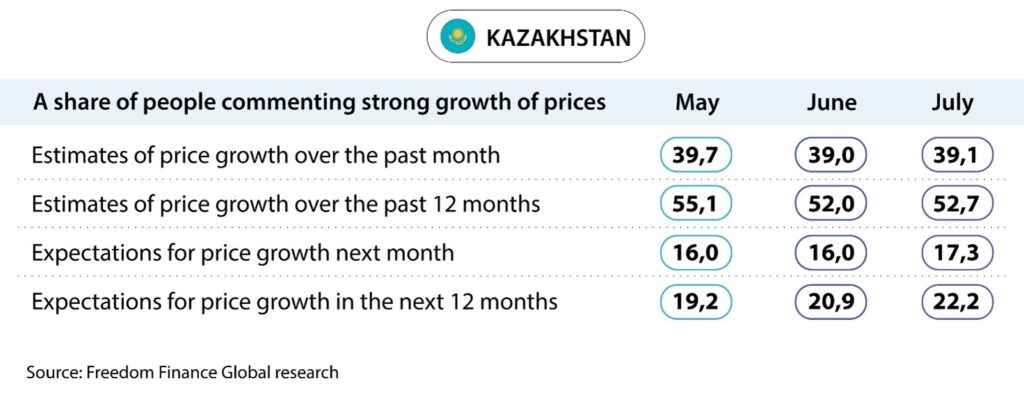
Devaluation expectations remain high
Devaluation expectations of Kazakhstanis remain high in July after June’s growth due to the sharp weakening of the tenge. According to the survey results, the share of Kazakhstanis expecting the tenge to weaken over a one-year horizon increased from 56.2 to a record 56.8%, but over a one-month horizon there was a noticeable decrease from 36.9 to 34.3%. Nevertheless, this figure is one of the highest for the entire research. It should be noted that compared to last July, the share of pessimists on these two issues increased by 4.6 and 5.5 p.p., respectively.
Uzbekistan
The Consumer Confidence Index of Uzbekistanis partially recovered in July 2024 after decline three months in a row. The CCI rose from 125.9 to 128.4 points. Separately for the sub-indexes, growth occurred in four of them, while the decline was very insignificant in one. The sub-index of favorable conditions for large purchases showed the greatest growth. Compared to July 2023, the CCI was virtually unchanged.
Dramatically improved conditions for large purchases
The sub-index of favorable conditions for large purchases and spending sharply improved by 7.7 points, reaching 88.7 points, which is 1.2 points less than the record figure. 41.2% of Uzbekistanis chose a positive answer, although there were 38.5% of them in June. The share of negative responses also dropped significantly by 5 p.p.
Among the age groups, young people under the age of 29 showed the greatest improvement in assessments. If the share of positive responses of young people reached 42.5% in the previous month, then it rose to 45.7% in July, which is also the best result among all ages. The results of the other three age groups were uniformly similar about 38.6–39.9%. The lowest share of positivity is observed among the people over the age of 60.
In the regional context, a significant improvement occurred in the Andijan region. There, the share of respondents who chose positive answers increased from 36.2% to 46.9%, which made the region the leader in July. At the same time, this share fell by 3.9 p.p. in the Khorezm region. The lowest result is in the Tashkent region, where this indicator decreased from 35.8 to 34.5%, which is not much less than in Tashkent itself.
Moderate growth in economic optimism
The second sub-index that showed the greatest recovery in July was the question of the forecast of changes in the economic situation over the 12-month horizon. The sub-index rose by a more modest 2.1 points and reached 150.1 points. 61.3% of Uzbekistan respondents chose positive answers, which is slightly less than the result of June. The growth of the sub-index was largely due to a decrease in the share of pessimists from 9.6% to 8.2%.
Among the age groups, a positive trend is observed only among young people under the age of 29. The share of young people who expect the economic situation to improve increased only by 0.1 p.p. On the other hand, the decline in the other three age groups is also insignificant and amounts to 0.2-0.6 p.p. The leader remains the people over the age of 60, where the share of optimists reached 64.8%.
In the regional context, major changes are recorded compared to June. The greatest increase in results is observed in the Bukhara region, where the share of people expecting an improvement in the economic situation increased from 58.3 to 61.7%. On the other hand, in the Republic of Karakalpakstan, the situation is mirrored – the share of optimists fell from 62.9 to 59.6%. At the same time, the worst indicator is in Tashkent – the share of positive answers was 51.4%. The leader of July was the Khorezm region with a similar indicator of 66.9%, which is only 0.2 p.p. less than in June.
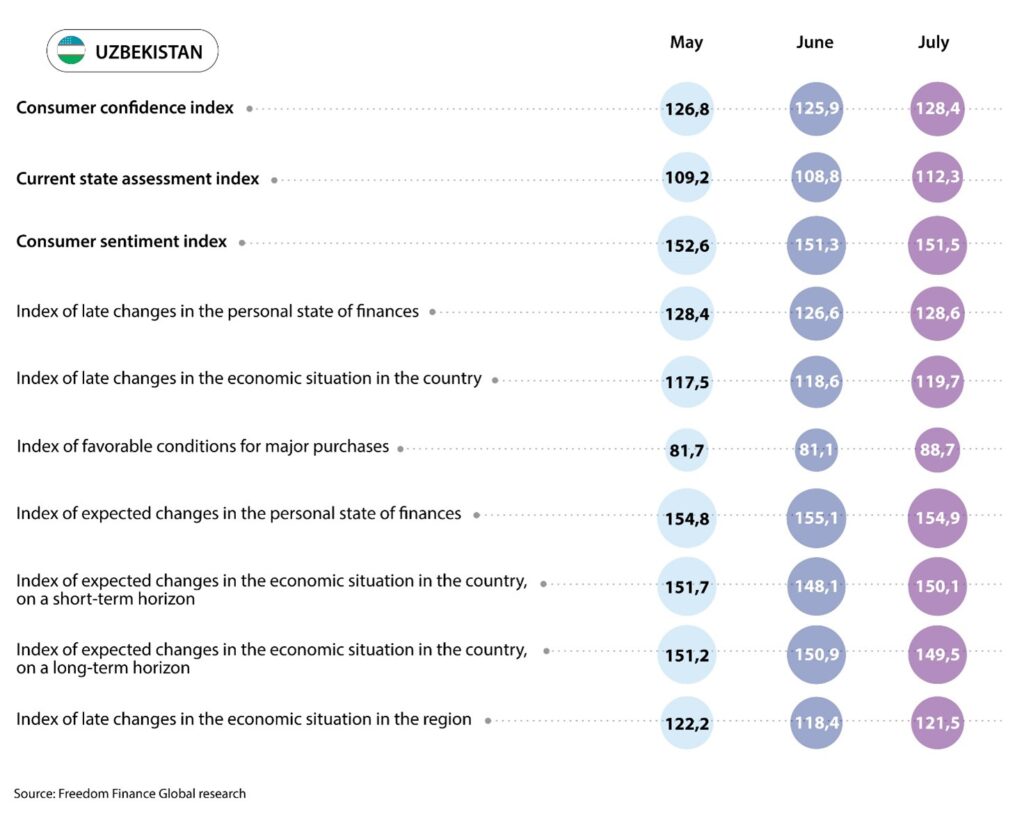
Inflation expectations and estimates remained unchanged
Generally, inflation estimates and expectations of Uzbekistan residents remained at the same level showing slight changes in the results. Thus, over the past year, 42.6% of residents felt a very strong increase in prices, compared to 44% in June. Over the past month, their share, on the contrary, increased slightly from 22.2 to 22.7%.
Inflation expectations also showed mostly neutral monthly dynamics after updating absolute lows in June. The share of those expecting a strong price increase next month increased from 10.5% to 11.4%. In the one-year horizon, 24.8% of respondents still expect faster price growth.
According to official statistics, monthly deflation was recorded again in July, which turned out to be slightly higher: 0.3%. Amid that fact, annual inflation slowed from 10.6 to 10.47%. The seasonal decline in prices for vegetables and fruits continues, which certainly had a positive effect on the mood of residents. Vegetables fell in price by 5.6% MoM, fruits and nuts by 11.2% MoM, although the latter increased in price by 0.3% MoM in July 2023. As a result, «fruits and vegetables» showed a new minimum for the entire research among the most highly appreciated goods and services. Only 13.1% of respondents chose this option, while their share was 17.2% in June, and 43% in July 2023. There is also a significant decrease in this indicator for the troublemakers of the past months, such as «housing services and utilities» and «drugs and medicines». If a record 50.4% of residents noticed a strong increase in prices for housing services and utilities in June, then this share fell to 44.8% in July. For drugs and medicines, the indicator fell from 32.2 to 23.9%. Nevertheless, these names are still in the top 3, along with «meat and poultry». For this category, the share of people who noticed a strong increase in prices increased from 42.2 to 45.2%. Still, progress is obvious compared to last year’s July: minus 19.5 p.p.
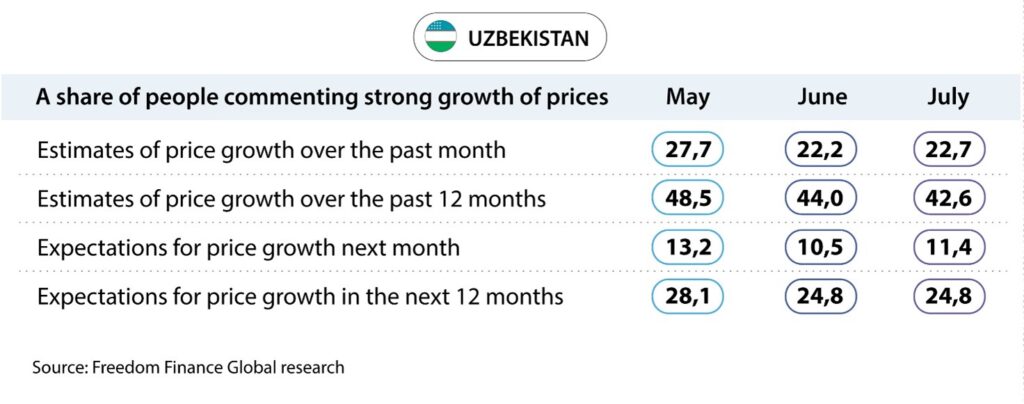
Continued decline in devaluation expectations
In July, the devaluation expectations of Uzbekistan residents decreased for the third month in a row updating the record low figures for the entire research. In July, the Uzbek sum continued to strengthen for the fourth month in a row, although it turned out to be much more insignificant than in previous months. The share of those who expect the sum to weaken against the dollar over the next 12 months has fallen from 56% in June to 53%. In the one-month horizon, the share of pessimists decreased from 35.7% to 33%. Compared to July 2023, the share of pessimists on these issues fell by 16.6 and 21.8 p.p., respectively.
Kyrgyzstan
In Kyrgyzstan, the Consumer Confidence Index rose for the fifth month in roe in July. The pace this time was much more moderate: 1.8 points, and the CCI was a record for the entire research of 138.4 points. All five sub-indexes defining the composite index level have increased again. Once again, the greatest growth is observed in the issue of current favorable conditions for large purchases. Compared to July 2023, the CCI increased by an impressive 11 points.
Favorable conditions for large purchases continue to set new records
The sub-index of current favorable conditions for large purchases is growing for the fifth month in a row. This time, the growth was a good 3.9 points. As a result, the sub-index reached 112.1 points in July, which is an absolute record in Central Asia for the entire research. 44% of residents indicate favorable conditions for large purchases, while this figure reached 43.3% in June. The main progress occurred in the share of negative responses. In June, it was 34%, while it fell to 30.8% in July.
Among the age groups, the older generation over 60 years of age showed the biggest improvement in July. If the share of negative responses among them reached 36.5% in June, it fell sharply to 29.3% in July. There is also an improvement in the other three age groups. However, the least pessimism is recorded among young people under the age of 29, where only 24.3% gave a negative answer (28.4% in June). People aged 30-44 years answered worse than the rest, 35.3% of them do not consider the current time as favorable for large purchases.
In the regional context, a sharp decrease in the share of negative responses (from 42.2 to 32%) compared to June is recorded in the Talas region. Nevertheless, the Jalal-Abad region remains the leader of July, where the same indicator reached only 23.3%, despite a small monthly increase of 2.1 p.p. Bishkek still occupies the last line in the rating, where the share of negative responses, although noticeably decreased from 44.5 to 39%, is still the largest among the regions.
Sharp annual growth of economic optimists
Over the past year, estimates of the economic situation have increased the most, apart from the sub-index of favorable conditions for large purchases. Over the year, this sub-index grew by a significant 17.6 points and reached a record 145.4 points. The share of people who positively assess changes in the economic situation increased from 55% in July 2023 to 66.4% in July 2024.
All four age groups showed an increase in optimism, but it is most pronounced in the 30-44 age group. There, the share of respondents who chose positive answers increased from 50.6 to 63.2% over the year, which is still the lowest figure in July among all age groups. A similar level of optimism growth is also recorded among young people under 29 and people aged 45-59. However, the leader is the older generation of people over 60, among whom the same figure increased from 64.9 to 73.1%.
In the regional context, strong growth is observed in Bishkek, Talas and Jalal-Abad regions. The share of respondents who say that the economic situation has improved has increased in these regions by about 19-21 p.p. In July, residents of Naryn region responded best, where the share of positive responses was 79.8%. The worst indicator is in the Chui region, it reached only 52.7%.
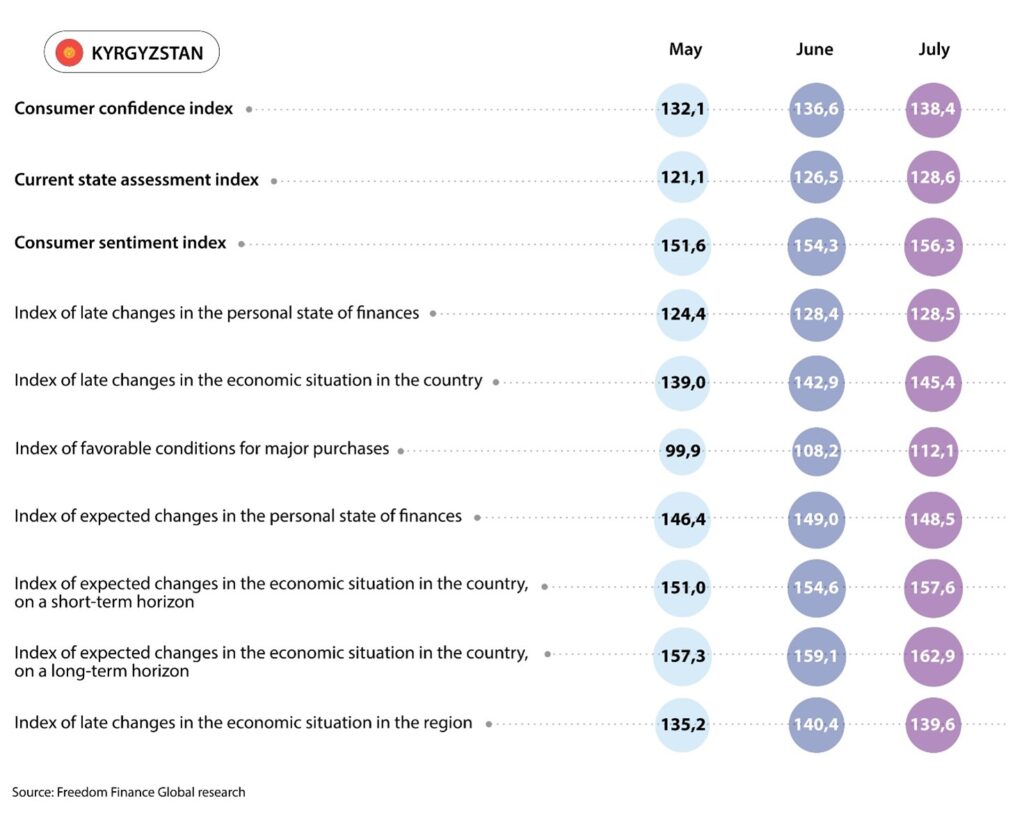
Inflation estimates and expectations again showed mixed dynamics
Inflation estimates of Kyrgyzstanis showed a slight increase in July after reaching record lows in May and June. If 25.6% of respondents felt a very strong increase in prices over the past month in June, then 27.5% of respondents felt a very strong increase in prices over the past month in July. At the same pace, estimates of price growth over the past 12 months increased after the June low. In July, 45.8% of Kyrgyzstanis recorded an acceleration in price growth, while this figure was 44% in June. Official data on annual inflation indicate a continuation of the decline in July from 4.5% to 4.1%, which is the lowest since February 2020.
For the most part, the inflation expectations of Kyrgyzstanis have decreased in contrast to the inflation estimates and are at lows for the entire research. The share of respondents expecting faster price growth in the next 12 months remained at a record low of 10.9%. However, the share of those who believe that prices will rise very much in the next month decreased from 7.9% to an absolute minimum of 5.9%.
Among the certain goods and services for which residents noticed the greatest price increase, we once again note flour, which continues to be the leader of the rating for at least the last 11 months. The share of respondents who chose flour increased slightly: from 46.9% to 47.9%. Also, note that the list of the top 5 products with the highest price increases has not changed for 11 consecutive months. In addition to flour in July, 45,2% of respondents mentioned vegetable oil, 38,9% sugar and salt, 36,2% meat and poultry, and 33,9% vegetables and fruits. We shall note the sharp monthly decline in vegetable prices by 11.3% MoM, after a strong increase in June. On the other hand, fruit prices continue to increase with a 2.9% MoM increase in July. Meat prices increased by a noticeable 1.1% MoM. While for the rest of the above-mentioned goods, prices approximately remained at the same levels.
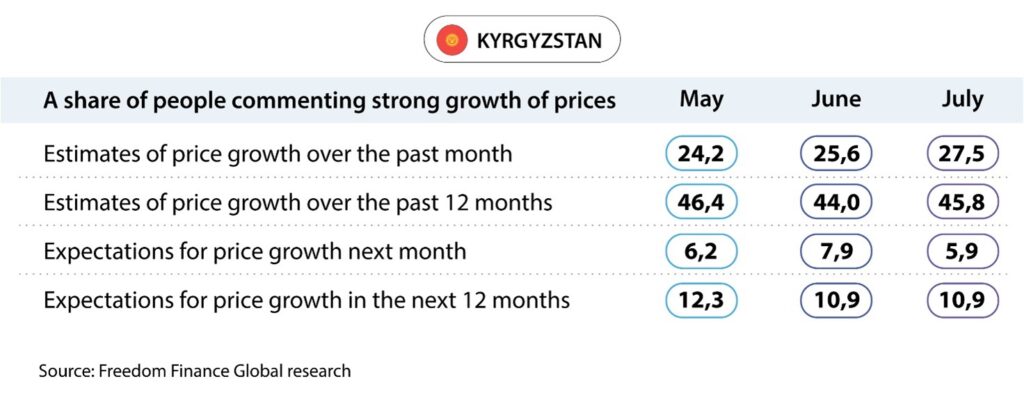
Devaluation expectations remain low
The Kyrgyz som continued to strengthen significantly in July for the fourth month in a row. Moreover, the dollar-som pair fell in value by 2.8%. The last time such a low exchange rate was observed was in November 2022. All this had a restrained effect on the mood of the Kyrgyz people, whose devaluation expectations generally maintained the status quo in July after updating record low values in June. If 25.6% of residents expected the som to weaken in a year in June, then the share of such people was 24.2% in July. However, on the issue of dollar growth in the horizon of one month, the share of pessimists, on the contrary, increased from 14.9 to 16.3%.
Tajikistan
The Consumer Confidence Index in Tajikistan rose sharply in July from 146.8 to 155.6 points after four months of stagnating at the same level. This indicator became a record in Central Asia for the entire research. All five sub-indexes showed significant growth. While, the greatest improvement was demonstrated by assessments of the current favorable conditions for large purchases, which reached a new record. Compared to July last year, the CCI increased by as much as 21.1 points mainly due to improved assessments of changes in the economic situation.
Conditions for large purchases reached a record
The sub-index on whether the current environment is favorable for large purchases and spending increased sharply in July by 19.8 points to 104.7 points indicating a predominance of positive responses over negative ones. 51% of respondents gave positive answers, compared to only 41.7% in June.
Among the age groups, improvement is observed across the entire front. While, the greatest progress in results is recorded in people aged 30-44 years. The share of optimists among them increased from 39.2% to 54% in a month, which makes them the leader among all age groups. Youth under 29, which was the leader in June, also showed an increase, but the share of positive responses reached only 51.1%. The older generation over 60 years took an honorable third place: the indicator was 46.3%.
In the regional context, a sharp improvement is observed in districts of republican subordination, where the share of optimists increased from 37.5% in June to 51.2%. Nevertheless, Sughd region became the leader of July with a result of 53.8%. At the same time, there is a reverse decline in the share of optimists in the Gorno-Badakhshan Autonomous Region. If this area showed the greatest progress in June, then the share of positive responses showed the opposite trend in July. In June, this share reached 55.2%, and it was already 46.8% in July.
Estimates of changes in the economic situation have increased significantly over the year
Residents’ assessments of changes in the economic situation showed a noticeable increase in comparison with both June and last year’s July. This sub-index rose to 175.4 points, which is a new record and indicates overwhelming optimism among respondents. The share of those who are optimistic in July was 85.8% compared to 79.5% in June and 61.4% a year ago.
Among the age groups, the growth of optimism is recorded in all age groups. While, the best dynamics is shown by the group of the generation over 60 years old, which became the leader in July. Among them, the share of optimists increased from 76.2% to an astronomical 92.2%. Last year, the same figure reached only 54.8%. In the other three age groups, this indicator is 83.7-86%. Respondents aged 30-44 years answered worse than the rest.
All regions have seen an increase in the proportion of residents who have noticed improvements in the economic situation over the past 12 months. At the same time, the results were quite uniform across regions. If the leader of July, the Gorno-Badakhshan Autonomous Region, has a share of optimists of 87.7%, then the figure is slightly lower in the Sughd region: 84.9%. The greatest progress is observed in Dushanbe, where the share of positive responses increased from 76.4 to 85.3%. Also in the capital, the share of optimists increased by as much as 31.4 p.p. compared to last year’s July.
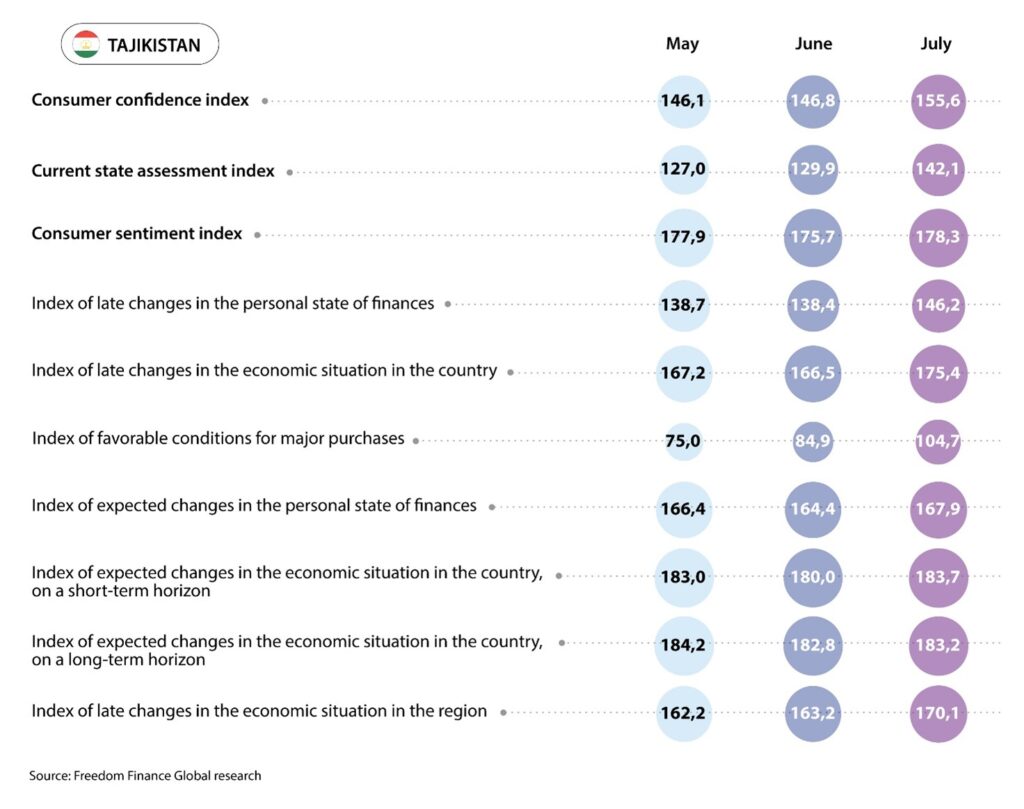
Inflation estimates and expectations remain at the same level
Tajikistanis’ inflation estimates and expectations showed little change in July and remain close to record lows. The share of respondents who noted a strong increase in prices over the past month increased from 18 to 18.1%. Over the past 12 months, the share of those who experienced a faster price increase also increased from 21.4% to 23.5%. The inflation expectations of Tajikistan residents showed an even more neutral result compared to June. 7.2% of residents expect a very strong price increase in the coming month, compared to 7.1% in June. Over the next 12 months, the share dropped slightly from 10.9% to 10.5%.
Official inflation data for July has not yet been released, but annual inflation fell slightly in June from 3.6% to 3.5%. Among some goods, Tajikistan residents were most concerned about the prices of meat and poultry, which took away many months of leadership from flour. Over the past month, the share of people who noticed a strong increase in prices for meat and poultry increased from 34.3% to 36.2%. While for flour, this indicator did not grow so significantly: from 34.6 to 35.6%. We note a noticeable decrease in the share of vegetables and fruits: from 28.1 to 20%, which is a new minimum for the entire research. At the same time, vegetables and fruits, along with vegetable oil, continue to be consistently in the top 4 items. According to official statistics, in June prices for meat and meat products increased by 2.6% MoM, and separately for beef immediately by 4.2% MoM. For fruits, prices seasonally fell by 1.8% MoM in June, while for vegetables, prices for the month decreased by another 5.2%, which eventually gave an annual price decrease of 13.4%.
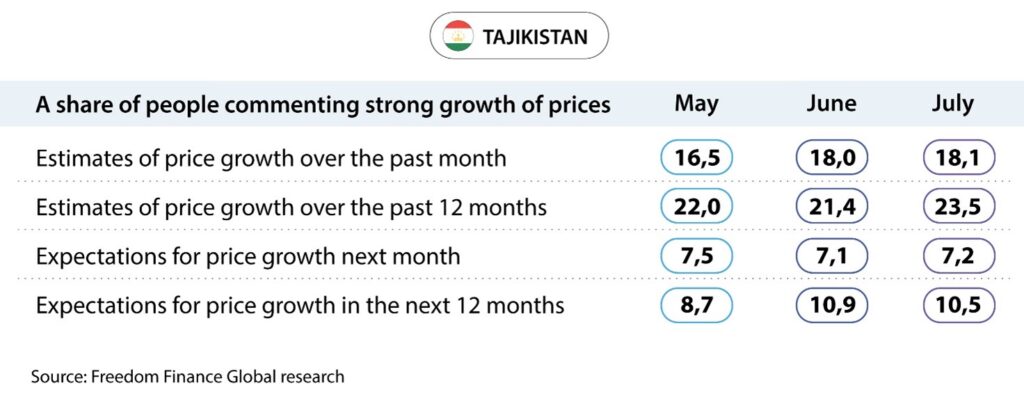
Devaluation expectations decreased slightly
In Tajikistan, devaluation expectations have mostly decreased and are near minimums in July. This is happening amid the dollar exchange rate against the somoni declining for the fourth month in a row. This time the rate fell by 0.5%, and by 3.1% since the end of March. The share of those who expect the national currency to weaken within a month has increased from 15.8 to 16.4%. 23.1% of the country’s population expects weakening within a year (25.2% in June).
Conclusions
July 2024 turned out to be positive for all Central Asian countries. In Kazakhstan, the Consumer Confidence Index (CCI) continued to grow for the fourth month in a row, which also became the third indicator for the entire research. In general, it is difficult to single out one of the issues where progress has been made. However, compared to last July, Kazakhstanis are more optimistic about the improvement in the economic situation. We should also note another increase in the CCI in Kyrgyzstan, which updated its record for the second time in a row and maintained its previous lead over Uzbekistan. All this happened thanks to another regional record for favorable conditions for large purchases. In addition, compared to July 2023, the CCI showed a noticeable increase of 11 points, including due to improved estimates and forecasts for the economic situation.
The situation changed dramatically for the regional leader in the CCI, Tajikistan, in July. Previously, the index was approximately at the same levels for four months in a row, but in July there was a sharp increase with an update of the absolute record in the region. This also happened due to a significant improvement in the assessments of the favorable conditions for large purchases. In addition, the CCI in Tajikistan showed the largest increase of 21 points compared to last year. But Uzbekistan finally showed recovery after three months of a consecutive decline in the CCI, which probably occurred amid rising prices for certain items. The CCI rose by 2.5 points also due to an improvement in the favorable conditions for large purchases. Nevertheless, compared to July 2023, the CCI remained almost at the same level, which makes Uzbekistan the only country in the region without progress in a year-on-year comparison.
It is interesting to note that the dynamics of inflation estimates and expectations were mostly neutral with a slight upward bias in all four countries in July. In Kazakhstan, unlike other countries, inflation parameters increased slightly in three out of four questions. This probably happened amid acceleration of annual inflation in July, but the indicators remain close to the minimums. In Tajikistan, a slight increase in pessimism is observed only in one of the four questions, while the changes in the rest are insignificant. In Kyrgyzstan, the dynamics of inflation estimates and residents’ sentiments were mixed. Growth estimates increased slightly, but remain close to the minimums, while inflation expectations decreased slightly. In Uzbekistan, the monthly change in results was also mixed with a slight decrease in growth estimates for 12 months to a record minimum, but at the same time with a slight increase in estimates in the period of the past month. It should be noted that the seasonal decline in prices for fruits and vegetables is observed in most countries, which has led to a drop in the proportion of people who have noticed a strong increase in prices for these products.
In Central Asian countries, devaluation expectations have once again demonstrated a multidirectional movement. While devaluation expectations continue to decline in Uzbekistan, they have remained at the same levels for the most part in other countries. In Uzbekistan, the share of people expecting the national currency to weaken in different time periods has fallen by another 2.8–3.1 p.p. As a result, devaluation expectations have updated record lows amid continued strengthening of the sum. Moreover, the share of those expecting the sum to weaken was 17–22 p.p. higher last year. In Kazakhstan, the tenge, which was neutral in July, affected the mood of residents. The increase in the share of pessimists over a 12-month horizon was small, but it was enough to update the absolute record. On the other hand, over a month, the share of those expecting weakening has decreased by a couple of percent. In Tajikistan, devaluation expectations have decreased over a one-year horizon, but have slightly increased over a one-month horizon. In Kyrgyzstan, the situation with devaluation expectations over a one-month horizon remains stable, while a new minimum has been reached over a one-year horizon. It should be noted that such dynamics in Central Asia are quite consistent with the dynamics of exchange rates in individual countries. Once again, the dollar is showing a weakening at the end of the month in the region, except Kazakhstan.
The thirteenth wave of the consumer confidence research of the population of four Central Asian countries showed a noticeable jump in the results and a change in the trends in two countries at once. The leader of the region, Tajikistan, whose index remained stable for four months, showed a sharp increase breaking the record for the region. Uzbekistan, where we previously recorded negative dynamics for three months, demonstrated a partial recovery. In the other two countries, the previous growth trends persist. In Kazakhstan, the growth that began in April continued and the index reached the third highest figure of all time. Kyrgyzstan, on the other hand, broke its own CCI record continuing to hold confidently second place. As a result, July can be called positive for all countries in the region compared to June. However, compared to 2023, this is not the case for Uzbekistan, where the index remained at the same level, while Tajikistan and Kyrgyzstan showed significant annual progress in the results.

